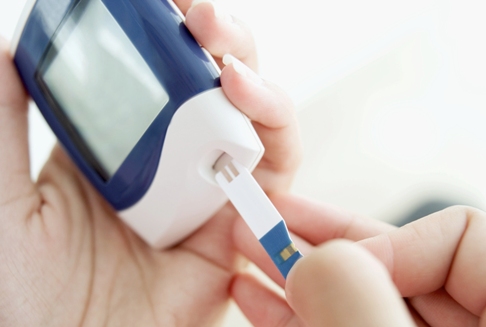Canadian Health Awareness Society : Resources
| Diabetes - Contents |
The Importance of Hypoglycemia in Pe... Dr. Kwang Yang, Family Medicine
An overview of high-risk proliferati... Dr. Kwang Yang, Family Medicine
The kidney and diabetes (2015) Dr. C. P. Lau, internist
2009 New Treatment for Diabetes Dr. C. P. Lau, internist
Diabetes and Sexual Dysfunction Dr. Kwang Yang, Family Medicine
Let's talk about Type 2 Diabetes Dr. Kwang Yang, Family Medicine
How to Prevent Diabetes? ---TCM vie... Dr. John Yang, Traditional Chinese Medicine
Diabetic Complications and Amputatio... Dr. Ian Yu, Podiatrist
An overview of high-risk proliferati... Dr. Kwang Yang, Family Medicine
The kidney and diabetes (2015) Dr. C. P. Lau, internist
2009 New Treatment for Diabetes Dr. C. P. Lau, internist
Diabetes and Sexual Dysfunction Dr. Kwang Yang, Family Medicine
Let's talk about Type 2 Diabetes Dr. Kwang Yang, Family Medicine
How to Prevent Diabetes? ---TCM vie... Dr. John Yang, Traditional Chinese Medicine
Diabetic Complications and Amputatio... Dr. Ian Yu, Podiatrist
| Diabetes - Detail |
The Importance of Hypoglycemia in People with Diabetes
Dr. Kwang Yang, Family Medicine

What is hypoglycemia?
Glucose is the main source of energy in our body, and the normal range of blood glucose is from 4.0 to 6.0mmol/L in an individual without diabetes. Hypoglycemia, also called low glucose or low blood sugar, occurs when the level of glucose falls drops below normal. It is commonly associated with the treatment of diabetes as many medications that are effective in treating diabetes carry the risk of lowering the blood sugar level too much, causing symptoms. This is especially important for patients and physicians to recognize, as the goal for treating patients with diabetes becomes tighter control of blood glucose.For many people with diabetes, hypoglycemia means a level of 4.0mmol/L or lower. However, a variety of conditions, many of them rare, can cause low blood sugar in people without diabetes. Hypoglycemia isn't a disease itself — it's an indicator of a health problem.
What are the symptoms of hypoglycemia?
When circulating level of blood glucose drops, the brain actually senses the fall. It sends out messages that trigger a series of events, including changes in hormone and nervous system responses aimed at increasing blood glucose levels. Insulin secretion decreases and hormones that promote higher blood glucose levels, such as glucagon, cortisol, growth hormone, and epinephrine all increase, and liver store of glycogen is converted to glucose rapidly. In addition to the biochemical processes that occur, the body starts to consciously alert the affected person that it needs food by feeling hungry.Most people will feel the effects of low blood sugar when blood glucose levels are lower than 3mmol/L, and symptoms of hypoglycemia tend to come on quickly and can vary from person to person. It may be mild or moderate, and sometimes people don’t even feel any symptoms.
Common signs and symptoms are:
- nervousness
- dizziness
- trembling
- sweating
- palpitations
- hunger
- weakness
- Pale skin
- Anxiety
- Tingling sensation around the mouth
- Confusion
- Inability to complete routine tasks
- Visual disturbances
- Seizures
- Loss of consciousness
Seek your doctor if:
- Mild or moderate symptoms of hypoglycemia occur without having diabetes
- For diabetic patients, hypoglycemia is not responding to treatment such as drinking juice, eating candy or glucose tablets.
- Symptoms of severe hypoglycemia occurs, then emergent measures and treatments are needed
Possible causes of hypoglycemia, with diabetes:
Imbalance between increase in insulin and amount of circulating blood glucose in body from - taking too much insulin or diabetic medications
- don't eat as much after taking diabetic medications
- exercise too much after taking diabetic mediations
- skipping or delaying a meal
Test and diagnosis:
Whipple's triad is used to diagnose hypoglycemia:- Signs and symptoms of hypoglycemia
- Check blood glucose level when symptoms occur and a draw a sample to send to laboratory
- Disappearance of signs and symptoms when blood glucose levels are raised
Treatment:
Early symptoms and if blood glucose level is below 4mmol/L, eat or drink 15 grams of fasting carbohydrates. Examples include- 4 glucose tablets or one tube of glucose gel
- 1/2 cup (120c.c.) of fruit juice
- 1/2 can (120 to 180c.c.) of soda—not low-calorie or reduced sugar
- 1 tablespoon of sugar, honey, or corn syrup
- If your next meal is more than 1 hour away, have a snack such as crackers to keep your blood glucose level in your target range.
- People with kidney disease should avoid orange juice but drink apple, grape, or cranberry juice as they don't contain much potassium.
- glucagon injection and call 911
- know when and how to use a glucagon emergency kit, and also tell family, friends or co-workers how it works
How to prevent hypoglycemia when you have diabetes?
- Check glucose levels regularly and as often as your doctor advises
- Eat regular meals and snacks
- Do safe and appropriate amount of physical exercise
- Discuss eating and exercise habit with you family doctor to optimize diabetes management plan
The Canadian Health Awareness Society is a registered non-profit organization. Our Mission is to promote health awareness on health issues for all Canadians by education, support and advocacy. Website: healthleader.ca.
References
National Institute of Diabetes and Digestive and Kidney Disease. Low Blood Sugar (Hypoglycemia). August 2016. 15 July 2017 Mayo Foundation for Medical Education and Research. Diseases and Conditions Hypoglycemia. 15 July 2017
Stoppler, Melissa Conrad. Low Blood Sugar Symptoms and Ranges. Ed. William C. Shiel Jr. 24 February 2017. 16 July 2017